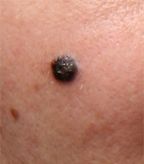New ASCO, SSO Guidelines for Sentinel Lymph Node Biopsy in Melanoma
Sentinel lymph node biopsy is recommended for patients with newly diagnosed intermediate-thickness melanomas, while the procedure may not be indicated for patients with thinner lesions, according to a new set of guidelines.
Sentinel lymph node biopsy is recommended for patients with newly diagnosed intermediate-thickness melanomas, while the procedure may not be indicated for patients with thinner lesions, according to a new set of guidelines from a joint panel convened by the American Society of Clinical Oncology (ASCO) and the Society of Surgical Oncology (SSO).

4-mm thick nodular melanoma; source: 0x6adb015, Wikimedia Commons
The new guidelines, which are based on a literature review of 73 studies published between January 1990 and August 2011, was published on the Web sites of both societies as well as in the Journal of Clinical Oncology, an ASCO publication, in July. The expert panel was co-chaired by Sandra Wong, MD, of the University of Michigan, and Gary Lyman, MD, MPH, of Duke University.
The meta-analysis yielded a set of key recommendations for the use of sentinel lymph node biopsy in melanoma. Cutaneous melanoma with Breslow thickness of 1 mm to 4 mm at any anatomic site is indicated for biopsy. The analysis, which included more than 25,000 patients in total, showed that routine use of biopsy in these patients provides accurate staging and acceptable rates of false negatives. Also, the more recent studies tended to report better procedural success than older trials, suggesting improvements in technical performance with more experience.
For thicker melanomas, though few studies specifically looked at these cases, the guidelines state that biopsy “may be recommended for staging purposes and to facilitate regional disease control.” Of eight studies that evaluated more than 100 patients with T4 melanomas, seven found that sentinel lymph node biopsy was a significant predictor of overall survival. Even the one study that found otherwise did show a difference in disease-free survival.
The joint panel found insufficient evidence to support recommending sentinel lymph node biopsy for melanomas that are T1 or less than 1 mm in Breslow thickness, but noted that the procedure can be considered in selected high-risk patients. Among the risk factors that could push the benefits of pathologic staging ahead of potential procedural risks are ulceration or a mitotic rate of at least 1/mm2.
Approximately 70% of all melanomas diagnosed in the United States are thin (T1, Breslow thickness less than 1 mm), and the overall risk of nodal involvement is low, at approximately 5.1%.
The final key recommendation notes that “completion lymph node dissection is recommended for all patients with a positive [sentinel lymph node] biopsy.” Without completion lymph node dissection, the literature suggests a 15% to 20% risk of developing regional nodal metastasis as the first recurrence site.
The guidelines address the need for further research on a number of unresolved questions surrounding sentinel lymph node biopsy in melanoma patients, including honing recommendations into more specific criteria for biopsy.
“Metastasis to regional nodes is the most important prognostic factor in patients with early-stage melanoma and has been shown to occur in approximately 20% of patients with intermediate-thickness tumors,” wrote the guideline authors. “As such, it is critically important to identify those patients for whom the expected benefits of resecting regional lymph nodes outweigh the risks of surgical morbidity.”